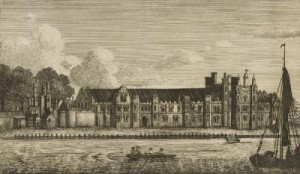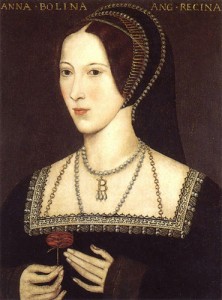On April 18, 1536 Chapuys met with Henry VIII at Greenwich.
On arrival, George Boleyn welcomed the ambassador and Cromwell presented Chapuys with a message from Henry, inviting him to visit Anne and kiss her hand. The ambassador could not bring himself to acquiesce and so begged Cromwell to excuse him, perhaps, for Chapuys’ sake, he should have accepted this more intimate encounter with Queen Anne because what was to follow was a much more public acknowledgement.
Rochford conducted the ambassador to mass and Eric Ives relates what took place.
‘Anne accompanied Henry from the royal pew down to the chapel to make her offering, and knowing that Chapuys was placed behind the door through which she entered, she stopped, turned and bowed to this representative of the Empire, and necessarily he responded likewise. After mass, Chapuys was careful not to go with the king and the other ambassadors to dine with Anne, but again it was her brother who entertained him in the presence chamber…’ (Pg. 313)
Chapuys recounts the encounter in a letter to Charles V,
‘I was conducted to mass by lord Rochford, the concubine’s brother, and when the King came to the offering there was a great concourse of people partly to see how the concubine and I behaved to each other. She was courteous enough, for when I was behind the door by which she entered, she returned, merely to do me reverence as I did to her. After mass the King went to dine at the concubine’s lodging, whither everybody accompanied him except myself, who was conducted by Rochford to the King’s Chamber of Presence, and dined there with all the principal men of the Court. I am told the concubine asked the King why I did not enter there as the other ambassadors did, and the King replied that it was not without good reason.’ (LP, x.699)
It’s difficult to believe that only two weeks after this triumphant victory for Anne, she would be arrested and imprisoned in the Tower of London. Even more disturbing, in 31 days – she would be no more.
SourcesIves, E. The Life and Death of Anne Boleyn, 2004.
‘Henry VIII: April 1536, 21-25’, Letters and Papers, Foreign and Domestic, Henry VIII, Volume 10: January-June 1536 (1887), pp. 287-310. URL: http://www.british-history.ac.uk/report.aspx?compid=75427 Date accessed: 18 April 2012



















I wonder what Henry meant when he said ‘it is not without good reason’!!
It’s ironic really, when someone who despised Anne as he did, finally payed her respect as Queen, when in a month time she had been arrested, tried and executed, and was Queen no more, how quick things changed at these times, in such a deadly way…a bitter- sweet victory.
I don´t understand, fail to see the triumph in this. As I see it, is it not like now days, saying “hi” to someone and that someone saying “hi” back? I mean, that´s just common courtesy. Wouldn´t it be a triumph if he had said “hi” first? By the way, why did Henry ordered that if he was already in a rough patch with Anne? I mean, like we say in my country, she was no longer “saint of his devotion”. Looks like Henry just really liked to make people submit to his wishes and no so much because he wanted Chapuys to show his respect to Anne
I suppose Brenda, it was that he was seen to be doing it, considering that everyone knew his contempt for Anne, (Henry too I would have thought), as you say it was more to do with Henry bending everyone to his will, not about Anne at all, but would have been seen as a triumph in certain eyes, albeit a hollow one, and completely meaningless, to modern eyes anyway…
Good point! I didn´t thought of that. Always nice to talk to someone who has answers ;D